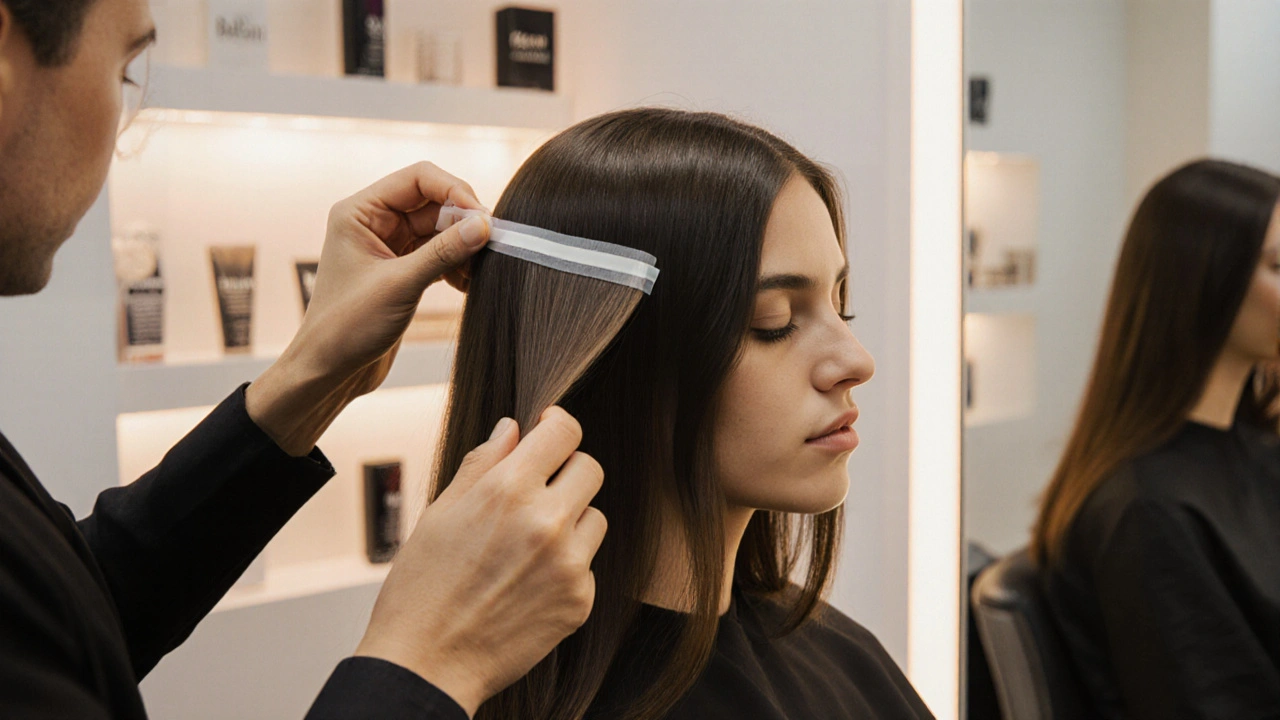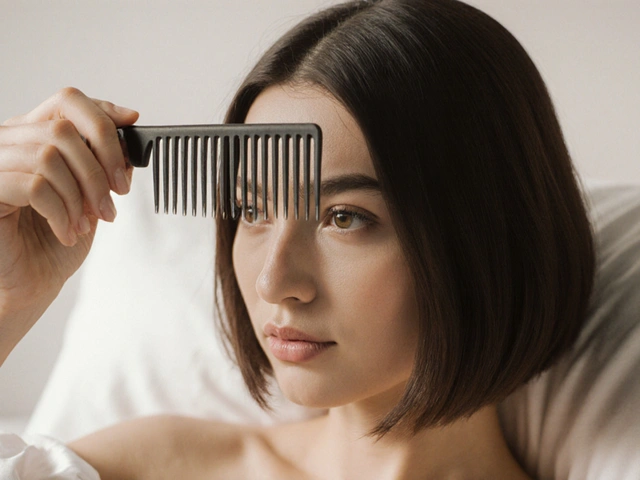Choosing between clip-in and tape-in hair extensions isn’t just about looks-it’s about your daily routine, budget, and how much time you’re willing to spend on upkeep. Both types give you instant length and volume, but they work completely differently under the hood. If you’re tired of spending hours at the salon or want to test out a new look without commitment, knowing which one fits your life matters more than which one looks prettier in a photo.
Clip-In Hair Extensions: Quick, Easy, Zero Commitment
Clip-in extensions are exactly what they sound like: strands of hair with small, metal clips attached. You snap them in before a night out, take them out before bed, and store them in a box until next time. No glue, no heat, no professional help needed.
They’re made from 100% human hair in most high-quality versions, so they blend naturally with your own hair. Brands like Great Lengths and Kinky Curly offer clip-ins that match real hair texture and color, even if you have curly or fine hair. The clips themselves are designed to grip securely without pulling-no one wants a hair extension falling out during a dance at a wedding.
Best for: People who want flexibility. If you work from home Monday through Friday but go out on weekends, clip-ins let you switch up your look without changing your routine. They’re also ideal if you’re unsure about committing to extensions long-term. Try them for a party, then go back to your natural hair the next day.
Downsides? They need to be repositioned every time you wear them. If you have thin hair, the clips can sometimes show, especially if your natural hair is shorter than 12 inches. And while they’re easy to put in, doing a full set well takes practice. First-timers often end up with lumps or uneven volume.
Tape-In Hair Extensions: Semi-Permanent, Natural-Looking, More Work
Tape-in extensions use thin wefts of hair bonded with double-sided adhesive tape. They’re applied in sections-usually 1-2 inches wide-between your natural hair. A stylist clips them in, then presses the tape to seal. Once in, they stay put for 6 to 8 weeks.
Unlike clip-ins, tape-ins move with your hair. You can wash, blow-dry, and style them like your own. High-quality tape-ins are made with virgin human hair, so they don’t tangle easily and last longer. The tape itself is medical-grade and designed to be gentle on your scalp. Brands like Hairdreams and Bellami use hypoallergenic adhesives that don’t damage hair when removed properly.
Best for: People who want a low-maintenance, natural look. If you’re tired of your flat, thin hair and want something that looks like it’s always been there, tape-ins are the go-to. They’re great for daily wear-whether you’re running errands, working out, or going on a vacation.
But here’s the catch: You can’t install them yourself. You need a trained stylist to apply them correctly. And every 6 to 8 weeks, you have to go back to have them removed and reinstalled. That means recurring costs-usually $300 to $600 per session, depending on your location and hair length.
How They Compare: Real-Life Scenarios
Let’s say you’re a teacher with a busy schedule. You don’t have time to spend 20 minutes putting in extensions every morning. Clip-ins might seem like a good idea, but if you’re constantly adjusting them during class, they’ll become annoying. Tape-ins stay put all day, so you forget they’re even there.
Now imagine you’re a college student on a budget. You want to look polished for interviews, but you can’t afford monthly salon visits. Clip-ins cost $50 to $150 upfront and last for years if you care for them. Tape-ins cost three times as much just to install, plus you’ll need to go back every two months.
What if you’re planning a wedding? Tape-ins give you a seamless, all-day look that holds up under lights and photos. But if you’re just doing a photo shoot or a date night, clip-ins give you the same effect without the commitment.

Longevity and Care
Clip-in extensions, if treated well, can last 12 to 18 months. You wash them once a week with sulfate-free shampoo, air-dry them, and store them flat. Avoid heat tools on high settings-your extensions aren’t your real hair, and they can melt or frizz.
Tape-ins last 6 to 8 weeks before needing reapplication. But they also need regular maintenance. You can’t wash your hair daily-overwashing loosens the tape. You need to use extensions-friendly products, and you should never sleep with wet hair. Brushing them gently from the ends upward prevents tangling.
Both types require the same basic care: no chlorine, no saltwater exposure without rinsing, and always use a heat protectant if you’re blow-drying or straightening. But tape-ins are more sensitive. One wrong move during washing, and the tape can come loose.
Cost Breakdown: Upfront vs Long-Term
Clip-ins: $50-$150 (one-time purchase). You buy them once, and they last for years. You might need a second set if you change your hair color, but that’s it.
Tape-ins: $300-$600 for the first application, plus $150-$300 every 6-8 weeks for maintenance. Over a year, that’s $800 to $1,800. Over two years? You’re looking at $1,600 to $3,600.
That’s not just money-it’s time. Every visit to the salon means taking time off work, driving there, waiting, and then dealing with the aftermath. Clip-ins? You do it yourself in 10 minutes while listening to a podcast.

Which One Should You Choose?
If you’re still unsure, ask yourself these three questions:
- Do you want to wear extensions every single day, or just for special occasions?
- Are you willing to spend money and time on regular salon visits?
- Do you have the patience to learn how to style and care for them properly?
If you answered yes to the first question, go with tape-ins. If you answered yes to the second or third, stick with clip-ins.
There’s no right or wrong answer here. It’s about matching the tool to your life. Clip-ins are the flexible, budget-friendly option. Tape-ins are the seamless, low-effort solution-for people who can afford the upkeep.
Pro Tips for Both Types
- Always buy 100% human hair. Synthetic extensions tangle, melt, and look fake under sunlight.
- Match the color to your natural hair at the roots, not the ends. That’s where the blend matters most.
- Don’t buy the cheapest set on Amazon. Cheap clips break, cheap tape falls out, and cheap hair sheds.
- Use a wide-tooth comb only. Brushing too hard causes breakage.
- Keep your natural hair healthy. Extensions don’t fix bad hair health-they expose it.
Neither clip-ins nor tape-ins are magic. They enhance what you already have. If your hair is dry, brittle, or damaged, extensions will make that worse if you don’t take care of your scalp and strands underneath.
Final Thought: Try Before You Commit
Many salons offer trial sets of clip-ins so you can test the look before spending on tape-ins. If you’re unsure, start with clip-ins. Wear them for a week. See how you feel. Do you love the way you look? Do you hate the daily routine? That’s your answer.
There’s no rush. Hair extensions are an investment-not just in money, but in time and effort. Choose the one that fits your life, not the one that looks perfect in a magazine.
Can I sleep with clip-in hair extensions?
No. Sleeping with clip-ins can damage both the extensions and your natural hair. The clips pull on your strands all night, leading to breakage and tension headaches. Always remove them before bed.
Can I swim with tape-in hair extensions?
You can, but it’s not recommended. Chlorine and saltwater break down the adhesive tape over time. If you swim often, rinse your hair with fresh water immediately after and avoid soaking the tape area. Consider wearing a swim cap.
Do tape-in extensions damage your hair?
When applied and removed correctly by a professional, tape-ins cause minimal damage. But if they’re left in too long, pulled out improperly, or applied to already damaged hair, they can cause breakage or thinning. Always follow your stylist’s care instructions.
How long do clip-in extensions last?
With proper care, high-quality clip-in extensions last 12 to 18 months. Wash them gently, avoid heat damage, and store them flat. Replace them when the hair starts shedding, tangling, or looking dull.
Can I color my hair with tape-in extensions in place?
No. Hair dye can damage the tape adhesive and cause the extensions to fall out. Always color your natural hair first, then install the extensions. If you want to change the color of your extensions, consult your stylist-they can tint them safely.







Aafreen Khan
November 25, 2025 AT 21:45Pamela Watson
November 26, 2025 AT 14:47michael T
November 27, 2025 AT 18:30Christina Kooiman
November 28, 2025 AT 09:48Michael Jones
November 29, 2025 AT 00:36allison berroteran
November 30, 2025 AT 06:41Gabby Love
December 1, 2025 AT 22:48Jen Kay
December 3, 2025 AT 15:16Sandi Johnson
December 3, 2025 AT 17:06Eva Monhaut
December 4, 2025 AT 10:55mark nine
December 4, 2025 AT 16:04